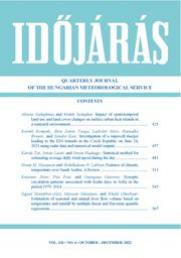IDŐJÁRÁS - angol nyelvű folyóirat
Vol. 126, No. 4 * Pages 425–582 * October - December 2022
 |
|
 letöltés [pdf: 8136 KB]
letöltés [pdf: 8136 KB]
Statistical method for estimating average daily wind speed during the day
Károly Tar, István Lázár, and István Hadnagy
DOI:10.28974/idojaras.2022.4.3 (pp. 481–510)
Károly Tar, István Lázár, and István Hadnagy
DOI:10.28974/idojaras.2022.4.3 (pp. 481–510)
IDŐJÁRÁS folyóirat

Az IDŐJÁRÁS a HungaroMet Nonprofit Zrt. negyedévenként megjelenő angol nyelvű folyóirata
Megrendelhető a journal.idojaras@met.hu címen.
A szerzőknek szánt útmutató itt olvasható.
Megrendelhető a journal.idojaras@met.hu címen.
A szerzőknek szánt útmutató itt olvasható.









